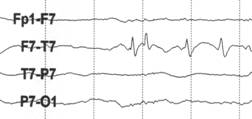Diagnosis - EEG
Electroencephalography (EEG) is the recording of electrical activity that comes from the cortex (outer covering) of the brain. EEG is one of the most useful tests for epilepsy because seizures are electrical events that directly involve the cortex of the brain. If certain risk factors suggest that the likelihood of having epilepsy is at least 50%, then a positive EEG means that there is over a 95% chance of actually having epilepsy. A positive EEG shows epileptiform activity that appears as sharply contoured or spike waveforms in the EEG signal between seizures. An example of epileptiform spikes from an EEG recording is shown below. Because these diagnostically useful waveforms occur between seizures, the patient does not need to have a seizure during EEG recording for the EEG to suggest the diagnosis of epilepsy. Nearly 50% of individuals with epilepsy will have epileptiform activity between seizures on their first EEG. Over 80% will have epileptiform activity if 3 EEGs with sleep are performed. The location and appearance of the epileptiform activity often helps to diagnose the patient's seizure type, information that is critical in choosing medications or considering other forms of therapy.

EEG interpretation is supervised by epilepsy specialists at the Epilepsy Center of Excellence who have board certification in EEG (American Board of Clinical Neurophysiology). An EEG is often performed at the initial clinic visit and the results are discussed during the visit, Repeated recordings may be necessary if an initial recording is unrevealing. EEGs are also used when withdrawing antiepileptic medications.
A routine EEG takes about 60 to 90 minutes from the time the patient enters the lab until they leave. Fifteen to 25 minutes are spent measuring the head and applying the electrodes (metal disks attached to wires). During the recording sleep is encouraged because it makes it more likely that epileptiform activity will be recorded.
Before EEG recording you will be requested to:
- Restrict the amount of sleep you get the night before the recording so that you will sleep during the test and make it more likely that epileptiform abnormalities will occur. In general, less than 3 hours of sleep is sufficient.
- Wash your hair thoroughly then night before testing. This is extremely important to ensure good contact between the scalp and the electrodes.
